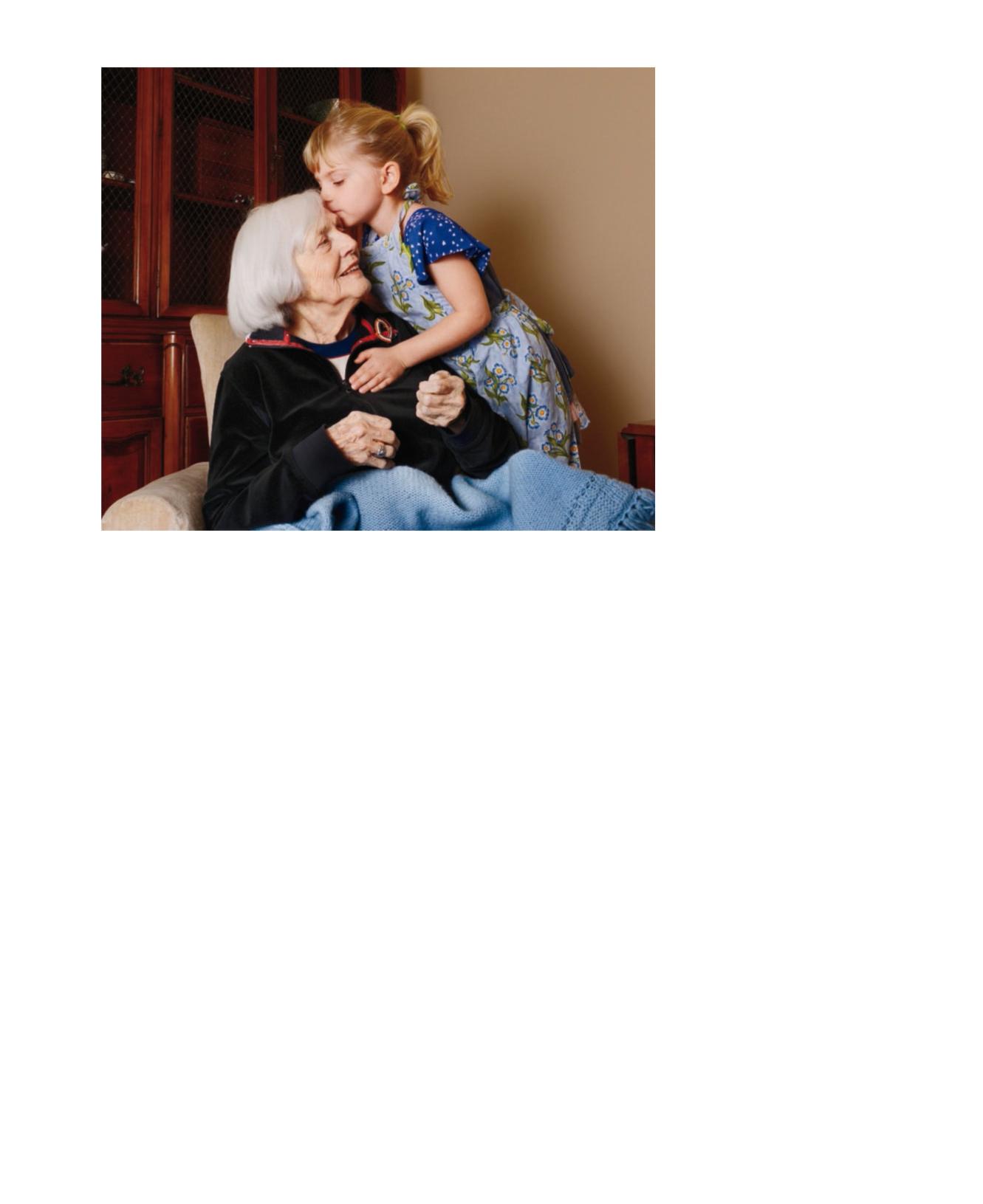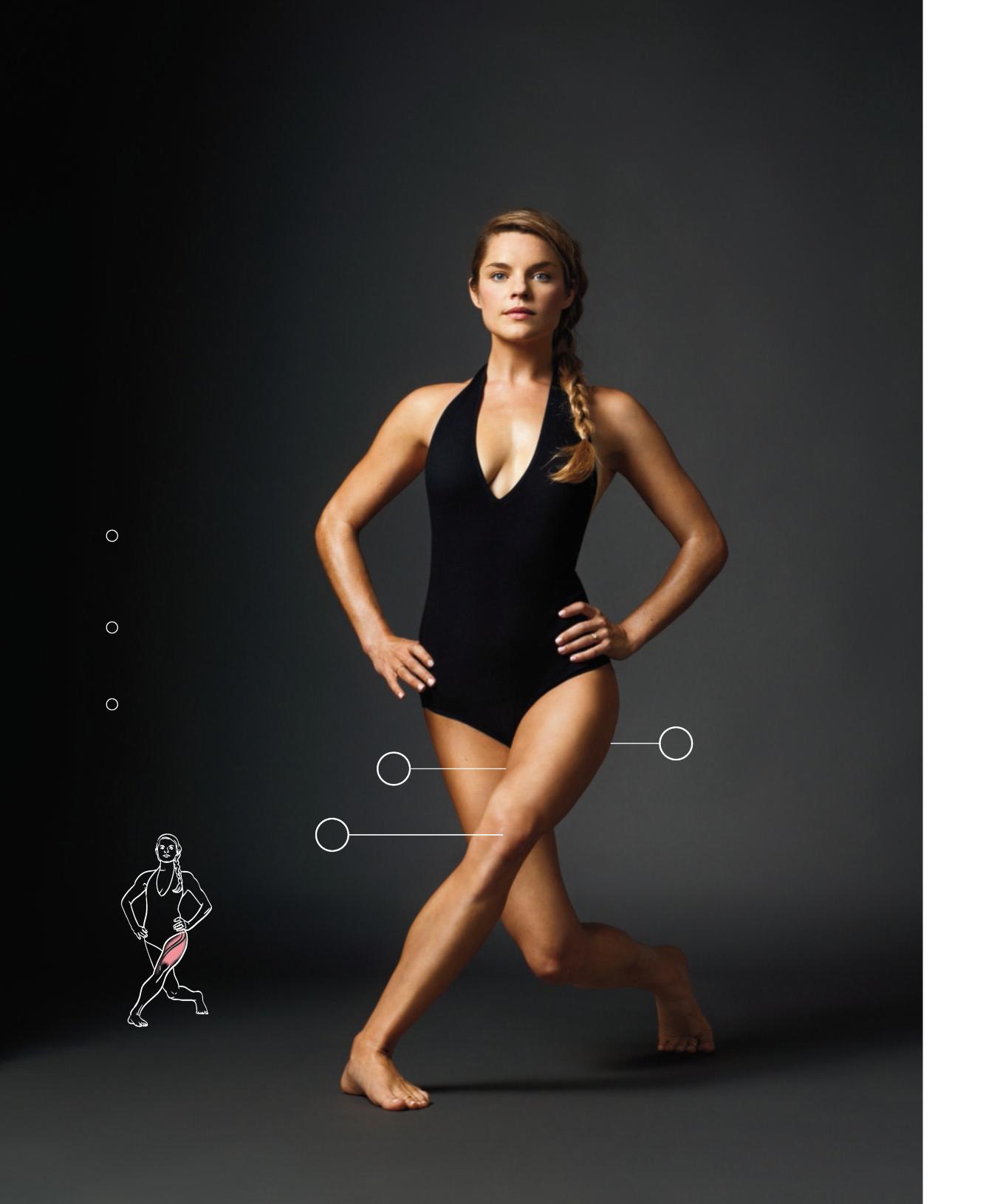
6 minute read
FASHION
The caregiver’s guide to good health
Nearly 24million Americanwomen provide care for another person.If you’re among them, here’s how to helpyour loved one—and yourself.
Advertisement
Written by Virginia Sole-Smith Photographs by Jessica Todd Harper
WHENSHEILAWARNOCK’SBEST friend,Susan,wasdiagnosed with cancer, more than20yearsago, WarnocksatwithSusaninthehospital,looked afterherdaughters, andlistenedassheventedherfears andfrustrations.Aroundthesame time,Warnock’s motherbegan her slow declinedue to several health problems,including dementia. Withinmonths,“I becametheclassic, burned-out,isolatedcaregiver,” recallsWarnock.“Iwasdepressed, couldn’tsleep,and completely put mycareer on hold.”
Warnock’sexperienceisn’t just common—it’sthenorm.Although manycaregiversreporta newsense ofpurposeandcloser ties to the personwhom they’re caring for, accordingtothe National Institute onAging, theexperience often comesat acost.Caregiverssuffer froma disproportionatenumber ofhealth andemotionalproblems— from depressiontopanicattacks. They routinelyskip health screenings,too,anddon’tseekmedical helpwhen they need it,evenas they scrambleto gettheir loved ones todoctors’ appointments. “It tookme too long toask other people tohelp mecare forSusanand my mother andmyself,”saysWarnock,whose

health struggles ledher tocofoundShare theCare, a nationalorganizationthat helpscaregivers form networks and findsupport.
Ifyou’rea caregiver,youmayfeel, well,stuck.Butmakingsmall, doable changes toyour routinecanhelp you care effectivelywhile keeping yourownhealth—and sanity—intact.
5ways to lighten any caregiving load
Areyoutakingontoo much?(Of courseyou are.)Youdon’thave toabandonyour roleasacaregiver toeasethe burden. Use these research- andexpert-backed solutionstofeel—andfunction—better.
1. RECLAIMYOUR ORIGINAL ROLE.
Caregiving changesthewayyou relateto thepersonyou’recaringfor. Butit’scrucial to retainsome of the oldpatterns,says Brian D. Carpenter, Ph.D.,anassociateprofessorof psychologyandaneldercareexpert atWashingtonUniversity,inSt. Louis. Forexample, askyour father foradviceaboutwork, evenifhe’s intheearlystagesofdementia.
Ifyou’recaring foran agingparent, asmanycaregiversare,don’tcall(or thinkof)whatyou’redoingas“parenting,”no matterhowmuchitmay sometimes feelthatway.“Your parent is first andforemostyour parent, regardlessofher physicalor mental state,”says Carpenter.“Youcan’t reversethatrole, and beingaware ofthatwillhelpherpreserve her dignity,aswell asyour relationship.”
2. CONNECT. Adultswho participatedin caregiving support groupsreported feeling lessburdened anddepressed and hadan improved senseofoverallwellbeing,accordingtoa2011 review published in InternationalJournal ofGeriatric Psychiatry.
“Most startoutsaying, ‘That’snot forme,’onlytolaterrealizeit’s exactlywhatthey need,” saysJennifer Merrilees,Ph.D.,aclinicalnurse specialistattheMemoryandAging CenterattheUniversityofCalifornia, SanFrancisco. Chalkituptothe word should. “You mightfeelyou should beabletohandleitonyour own,wheninfactthat’sarecipe for isolationandfatigue.Talkingto other peopleinyoursituationcanmake youfeel lessalone andgiveyou practicalcaregiving ideas,too,”says StevenHuberman, Ph.D.,acaregiving researcherandthefounding dean oftheTouroCollegeGraduate School ofSocialWork,in NewYork City.
Look foragroupthat’srun bya clinicalsocialworker,apsychologist, ora psychiatrist, advisesRandi Kaplan,alicensedsocialworkerand thedirectorofthe CaregiverSupport Program atMontefioreHealth System,inNewYorkCity.The more specific thegroup(“forcaregivers ofpeoplewithcancer”), themore you’re likelytobenefitfromthe experience.Give it afewsessions to seeifit’sagoodfit. Ifyou don’tfeel supported orunderstood—or simply don’t feelbetter—afterseveral meetings, switch groups,saysKaplan.
Manycommunityorganizations and hospitalsoffersuch groups. You canalsocontactyour localArea AgencyonAging (N4A.org)fora recommendation,or findonline groups atcaregiver.org.Ifyou really don’twant to join,seekone-onone help fromasocialworkerora therapistwith caregivingexperience,says Kaplan.
3.THINK OF EXERCISEASYOUR
LIFELINE. No,thereis no such thing asacaregivingcure-all,butphysical activity comes close, says Karen Robinson,Ph.D., thedirector ofthe MemoryWellnessInitiative at the Universityof Louisville,inKentucky.
Exercise is adirectand almost immediate remedyforthe top complaintsamong caregivers—lack ofenergy,sleepwoes,stress,pain, and depression,accordingto a 2006 NationalAllianceforCaregiving(NAC) survey.Addressing those issues has asecondarybenefit: “Researchshows that ifyou stay healthy,your lovedone ismore likelytoaswell,”says Robinson.
Even15to 20 minutes ofactivity most daysisenough to makeadifference,saysRobinson.Ifyourloved oneisstillmobile, consider afamily gymmembership,soyoucanboth go. (YMCAs oftenofferprograms for seniorcitizensand peoplewith disabilities.) Or focus onat-homeworkouts.Strength trainingis especially beneficialifyou helpmoveorlift anotherperson,soinvestinaset of handweightsorresistance bands.
4.TRYTO CULTIVATE INNER CALM.
Caregiverswhodideightsessions ofmindfulnesstraining (classes wheretheylearnedto observeand accept their physical andmental states) for twomonthsfelt less depressed,sleptbetter,andbelieved their overallqualityoflife had improved,accordingto asmall2015
The average caregiver in the UnitedStates is a 49-year-oldwoman caring for a 69-year-old relative. She provides nearly25 hours of service aweek and will spend at least fouryears in her role, even though she probablyworks full-time and is marriedwith children of her own, according to statistics from the NationalAlliance for Caregiving andAARP.
study of 37people at Northwestern University, in Evanston, Illinois. Yoga,meditation,and cognitivebehavioraltherapyall increase mindfulness, saysKen Paller,Ph.D., thestudy authoranda professor of psychology at Northwestern.(Check out thismonth’sBreathecolumn, page 52, fora quickstress-reliever.)
5. SAYYESTO HELP. Youknowyou should askfor—and accept—assistance.Sowhyareyoustill doing almosteverythingyourself?“Logically,youunderstand thatdelegating isa must,”says Kaplan. “Butemotionallyyou’re listeningto thelittle voiceinyour headthatsays, ‘This isyour responsibility.Youshould be able to handleit.’”
Thefix?“Makeyesyour default response to offersofhelp,”says Huberman. “Yourbrother offersto get groceries, even though theywon’t be exactlywhatyouneed?Sayyes. A memberofyour synagogue says she’llbringdinnerover?Yes again.”
Iftheoffersaren’tflying inor aren’tsufficient,askyourloved one’sfamilymembers,friends,and colleaguestojoinyouforaninformalmeeting. Comeupwitha listof thecaregivingtasksyoucould unload,then seewhoiswillingto handlethemona daily,weekly, or monthlybasis.(This canalsobe accomplishedvia e-mail orGoogle Docs. Butyou’remore likely to haveamore nuancedandproductive conversationinperson, says Warnock.)Visitsharethecare.orgto download freeresources fororganizinga caregiving group.
Acceptthatthe helpyou getmay be lessthan perfect.“No one’sgoing todoitexactlyright,”saysHuberman. “And that’s OK. It doesn’t mean thatyou’refailingyour loved one.”

3 types of caregiving (and how toweather each one)
Differentsituations posedifferent challenges.Here is somespecific adviceforyou.
IFYOU CARE FOR: Someone who lives with you
CATCH ABREAK, ALREADY. It’strue that most caregiverstendtobe overworked, but the24/7schedule ofbeing alive-incaregivercan putyou ataparticularlyhighriskfor burnout, saysMarionSomers,Ph.D., theauthorof Elder CareMade Easier andthe former directorof Hunter College’s BrookdaleCenter for HealthyAging,inNewYorkCity.
Ifyourfriendsor familycan’t committogivingyoutime off every week,askyourlocalAreaAgency onAgingaboutcommunity resources, likeadultday care, says Somers. Or hireapersonal-care assistant,whoistypically nota medical professionalbutsomeone whohas experiencewithcaregiving. Ratesrunaround $10to$25 anhour;you canfindcandidates through communityseniorand aging organizations.(You’ll also find resourcesforhiring in-home help byclickingonyourstateintheFamilyCare Navigator at caregiver.org.) Ifmoneyistight,asklocalcolleges thatofferdegreesineldercare and nursing about interns.
Inaperfectworld,youwould go ona one-weekvacationevery six monthswhileanotherfamilymembertookyourplace.But ifyou can’t,“youshould stilldosomething that makesyoufeelgood every singleday,even if it’s only for10to 20 minutes,” saysCarpenter.“Bringingoldroutines andfamiliarpleasurestoyournewlifecan serve as a daily reprieve.”
TRY OUR grain frEE
REAL MEAT, POULTRY OR FISH IS THE #1 INGREDIENT IN DRY AND PATÉ NO NO NO

CORN, WHEAT OR SOY POULTRY BY-PRODUCT MEAL ADDEDARTIFICIALCOLORS, FLAVORS OR PRESERVATIVES
Get your trial offer at TryBeyondToday.com
while supplies last.
IFYOU CARE FOR: Someone who lives nearby
SET ASCHEDULE. Not livingwith thepersonyou’recaringforcreates itsownkind ofchaos.“It’seasyto getcaughtina trap, feeling likeyou have torunoverforeverylittle thing,”saysWarnock.To avoidcommuting- anderrand-induced fatigue, decidewhichdaysoftheweek you’llvisit.Then, barring emergencies,stick tothatschedule,soboth youandyour loved onehave clear expectations. (Again, ithelpsto ask othersto handleerrandssuch asdeliveringfood.)
IFYOU CARE FOR: Someone who lives far away
REMEMBERWHO’S IN CHARGE.
(HINT: IT’S NOTYOU.) As alongdistance caregiver,youobviously don’thave control overyourloved one’sday-to-dayissues.(Isyour motherreally takingherpills?Are herhome-healthaidesshowing up whenthey’resupposed to?) So accept thatfactand defertothe primarycaregiver.
“My mother is in her90sand lives inWisconsin,”saysGregoryJohnson, a senioradviser forfamily caregiving atEmblemHealth,an insurance companybased in NewYork state. “Tohelpcopewiththe distance, I putanoteby bothof my phones that says,‘Kathy[my sister]isthe primary caregiver.’ Ican offer input andsupport, butwhen itcomes tofinaldecisions,Idefertoher.” (You canalsodownloadtheNational Alliance forCaregiving’s Handbook forLong-DistanceCaregivers at caregiver.org.)
BE OF SERVICE Find three ways to support the caregiver in your life at realsimple.com/care.
The senior population is set to nearly double by 2030, so even ifyou’re not an active caregiver right now, odds areyou will be someday.

health
5-MINUTE TRAINER
CURTSY LUNGE
What it is
To tone and tighten your lower body, steal a move from charm school. The curtsy lunge works the major muscles in your hips, buttocks, and thighs, including the tough-to-target sartorii (the long muscles that run the length of your upper legs). And because it involves both strength and coordination, “this exercise will improve your posture and balance, too,” says Cathe Thompson, a group fitness manager at Equinox Fitness in New York City, who created this workout exclusively for Real Simple.
BODY CHECK
1 If the tops of your inner thighs don’t touch when you’re in the starting position, step farther to the left with your right leg. 2 Don’t let your front knee jut in front of your toes as you do the move. This can put undue strain on your knee joint. 3 Aim to keep about three-quarters of your weight on yourfrontleg. This will help youkeep your balance and also tone your thighs more effectively.
2 1
STEP IT UP A NOTCH
Hold a 2- to 10-pound dumbbell in each hand. As you do the move, allow your arms to hang naturally at your sides, with your palms facing your body.
3 How to do it
STAND straight, so that your feet are in line with your hips. Place your hands on your hips.
STEP back with your right leg, so that it’s about two feet behind your hips and crosses just past your left leg.
BALANCE on the ball of your right foot so that your right heel is lifted and your right knee is straight (or almost straight). Then bend your left knee slightly. This is the starting position.
BEND both knees slowly until your right knee lowers three to four inches. As you bend, keep your back straight, chest lifted, and left foot flat on the ground. Pause at the bottom of the move.
PRESS from your left foot, keeping your right heel off the ground, then slowly return to the starting position.
REPEAT 10 to 15 times, then change sides. Complete three sets on each leg, three times a week.
Muscles trained
Gluteals, hip adductors, quadriceps, and sartorii.
Written by
Kimberly Dawn Neumann
Photograph by
Henry Leutwyler










